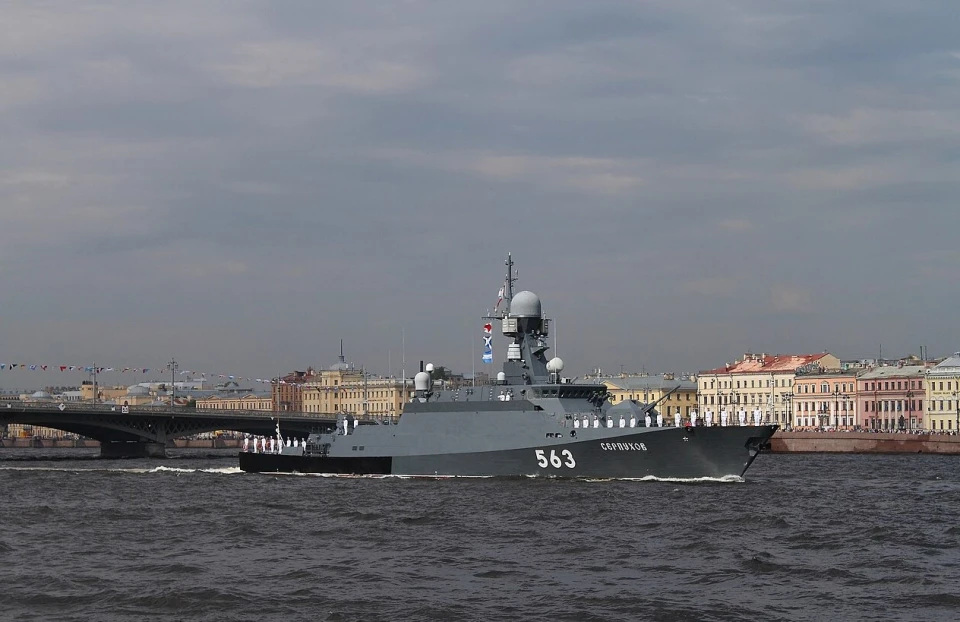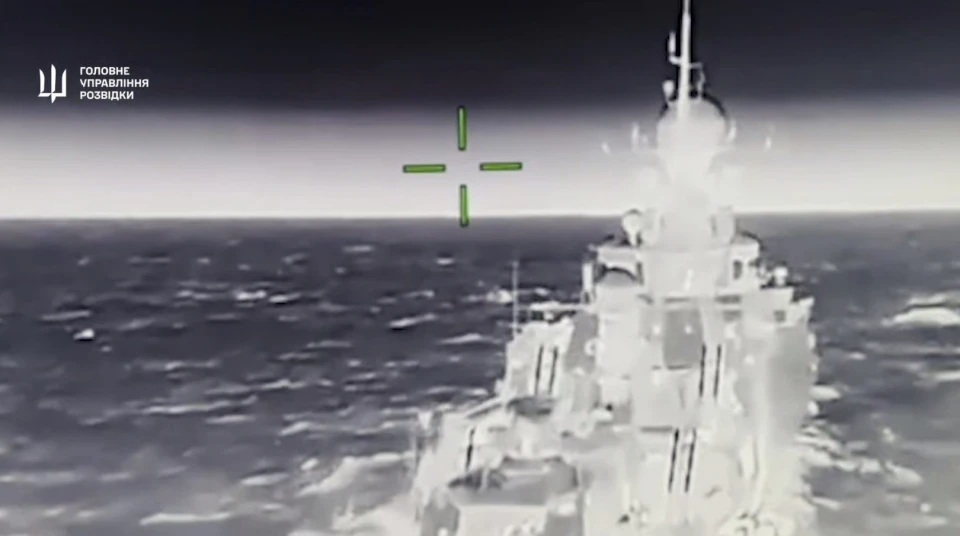Russian Buyan-M missile corvette hit near Crimea: Why these warships are dangerous and how many remain
global.espreso.tv
Thu, 28 Aug 2025 19:34:00 +0300

Contents:History of the Buyan-M shipsHow many remain and where they patrolWhy the Buyan-M is dangerous for UkraineUse of Kalibr missiles and how many vessels Ukraine has already destroyedWhat is known about the August 28 attackThis incident is another blow to Russia’s Black Sea Fleet, which has regularly suffered losses from Ukrainian forces since the start of the full-scale war. Espreso explains what makes the Project 21631 Buyan-M ships dangerous.History of the Buyan-MProject 21631 (Buyan-M) is a modernized version of the Buyan small missile ships, developed by the Zelenodolsk Design Bureau (Tatarstan). They were designed for the Russian Navy as multipurpose “river-sea” class ships to guard the economic zone in internal seas like the Caspian, Black and Azov Seas.The first ship, Grad Sviyazhsk, was laid down in 2010. The initial order of five ships expanded to 12. Compared to Project 21630, the Buyan-M nearly doubled displacement (949 tons vs. 560 tons) and received more powerful weapons. Initially they were to use German MTU engines, but after sanctions in 2014, China’s CHD622V20 engines and later Russia’s Kolomna 16D49 engines were installed.In 2016, the cost of building three ships was estimated at 27 billion rubles ($403 million), or about $130 million each. The ships are 74 m long, 11 m wide, and 6.5 m high, with a crew of 36–52. Fleet composition and patrol zonesAs of December 2023, Russia officially had 11 Buyan-M ships, with the last, Stavropol, undergoing trials.Caspian Flotilla: Grad Sviyazhsk, Uglich, Veliky Ustyug, Stavropol (under commissioning)Black Sea Fleet: Vyshny Volochyok, Orekhovo-Zuyevo, Ingushetia, Grayvoron (one of these was damaged by Ukraine)Baltic Fleet: Zeleny Dol, Serpukhov, Grad, Naro-FominskThanks to their “river-sea” class, the ships can be redeployed via internal waterways such as the Volga-Don Canal, making them flexible assets in the Caspian, Black, Azov, and Baltic seas.
Fleet composition and patrol zonesAs of December 2023, Russia officially had 11 Buyan-M ships, with the last, Stavropol, undergoing trials.Caspian Flotilla: Grad Sviyazhsk, Uglich, Veliky Ustyug, Stavropol (under commissioning)Black Sea Fleet: Vyshny Volochyok, Orekhovo-Zuyevo, Ingushetia, Grayvoron (one of these was damaged by Ukraine)Baltic Fleet: Zeleny Dol, Serpukhov, Grad, Naro-FominskThanks to their “river-sea” class, the ships can be redeployed via internal waterways such as the Volga-Don Canal, making them flexible assets in the Caspian, Black, Azov, and Baltic seas. Why they are dangerous for UkraineThe main threat is their Kalibr-NK missile system, capable of firing up to eight Kalibr or Onyx cruise missiles. Kalibrs can strike ground targets at 1,500–2,000 km and naval targets at up to 500 km, allowing strikes deep inside Ukraine from Black or Azov waters.Although Buyan-M ships have weak air defenses (short-range Gibka SAMs and AK-630M-2 “Duet” CIWS), their compact size, maneuverability, and ability to operate in shallow waters make them hard to detect and neutralize.Use of Kalibr missiles and how many vessels Ukraine destroyedRussia has used Buyan-M ships extensively to fire Kalibrs at Ukraine. Since February 2022, it has launched hundreds of such missiles. By early 2024, over 800 had been fired, though usage later declined—likely due to stock shortages and a shift toward Shahed drones.Ukraine has already damaged or destroyed multiple Buyan-Ms. For example, in October 2023 one struck a naval mine in Sevastopol. At the end of 2024, Ukraine’s Military Intelligence (HUR) reported that 15 Russian ships and vessels had been destroyed or damaged by Magura V5 naval drones, significantly weakening Russia’s maritime ambitions.Overall, Ukraine has eliminated or disabled around 60 Russian vessels since the invasion, including the cruiser Moskva and numerous landing and patrol ships.The August 28 attack
Why they are dangerous for UkraineThe main threat is their Kalibr-NK missile system, capable of firing up to eight Kalibr or Onyx cruise missiles. Kalibrs can strike ground targets at 1,500–2,000 km and naval targets at up to 500 km, allowing strikes deep inside Ukraine from Black or Azov waters.Although Buyan-M ships have weak air defenses (short-range Gibka SAMs and AK-630M-2 “Duet” CIWS), their compact size, maneuverability, and ability to operate in shallow waters make them hard to detect and neutralize.Use of Kalibr missiles and how many vessels Ukraine destroyedRussia has used Buyan-M ships extensively to fire Kalibrs at Ukraine. Since February 2022, it has launched hundreds of such missiles. By early 2024, over 800 had been fired, though usage later declined—likely due to stock shortages and a shift toward Shahed drones.Ukraine has already damaged or destroyed multiple Buyan-Ms. For example, in October 2023 one struck a naval mine in Sevastopol. At the end of 2024, Ukraine’s Military Intelligence (HUR) reported that 15 Russian ships and vessels had been destroyed or damaged by Magura V5 naval drones, significantly weakening Russia’s maritime ambitions.Overall, Ukraine has eliminated or disabled around 60 Russian vessels since the invasion, including the cruiser Moskva and numerous landing and patrol ships.The August 28 attack According to HUR, the August 28 operation against a Buyan-M near the Kerch Strait was complex: a drone first hit the ship’s radar, then another UAV struck the hull. The vessel was damaged and forced to withdraw from combat duty in the Temryuk Bay area.“Of course, it won’t sink from such damage. But disabling the radar will force it to return to port for expensive repairs and sideline it for some time,” analysts at Defence-UA noted.They added the strike prevented the ship from launching a Kalibr missile attack. Experts believe two different drones were used—likely upgraded RUBAKA and UJ-26 Bober, both previously seen striking Russian targets in occupied Crimea and evading Pantsir-S1 air defense systems.
According to HUR, the August 28 operation against a Buyan-M near the Kerch Strait was complex: a drone first hit the ship’s radar, then another UAV struck the hull. The vessel was damaged and forced to withdraw from combat duty in the Temryuk Bay area.“Of course, it won’t sink from such damage. But disabling the radar will force it to return to port for expensive repairs and sideline it for some time,” analysts at Defence-UA noted.They added the strike prevented the ship from launching a Kalibr missile attack. Experts believe two different drones were used—likely upgraded RUBAKA and UJ-26 Bober, both previously seen striking Russian targets in occupied Crimea and evading Pantsir-S1 air defense systems.
 Fleet composition and patrol zonesAs of December 2023, Russia officially had 11 Buyan-M ships, with the last, Stavropol, undergoing trials.Caspian Flotilla: Grad Sviyazhsk, Uglich, Veliky Ustyug, Stavropol (under commissioning)Black Sea Fleet: Vyshny Volochyok, Orekhovo-Zuyevo, Ingushetia, Grayvoron (one of these was damaged by Ukraine)Baltic Fleet: Zeleny Dol, Serpukhov, Grad, Naro-FominskThanks to their “river-sea” class, the ships can be redeployed via internal waterways such as the Volga-Don Canal, making them flexible assets in the Caspian, Black, Azov, and Baltic seas.
Fleet composition and patrol zonesAs of December 2023, Russia officially had 11 Buyan-M ships, with the last, Stavropol, undergoing trials.Caspian Flotilla: Grad Sviyazhsk, Uglich, Veliky Ustyug, Stavropol (under commissioning)Black Sea Fleet: Vyshny Volochyok, Orekhovo-Zuyevo, Ingushetia, Grayvoron (one of these was damaged by Ukraine)Baltic Fleet: Zeleny Dol, Serpukhov, Grad, Naro-FominskThanks to their “river-sea” class, the ships can be redeployed via internal waterways such as the Volga-Don Canal, making them flexible assets in the Caspian, Black, Azov, and Baltic seas. Why they are dangerous for UkraineThe main threat is their Kalibr-NK missile system, capable of firing up to eight Kalibr or Onyx cruise missiles. Kalibrs can strike ground targets at 1,500–2,000 km and naval targets at up to 500 km, allowing strikes deep inside Ukraine from Black or Azov waters.Although Buyan-M ships have weak air defenses (short-range Gibka SAMs and AK-630M-2 “Duet” CIWS), their compact size, maneuverability, and ability to operate in shallow waters make them hard to detect and neutralize.Use of Kalibr missiles and how many vessels Ukraine destroyedRussia has used Buyan-M ships extensively to fire Kalibrs at Ukraine. Since February 2022, it has launched hundreds of such missiles. By early 2024, over 800 had been fired, though usage later declined—likely due to stock shortages and a shift toward Shahed drones.Ukraine has already damaged or destroyed multiple Buyan-Ms. For example, in October 2023 one struck a naval mine in Sevastopol. At the end of 2024, Ukraine’s Military Intelligence (HUR) reported that 15 Russian ships and vessels had been destroyed or damaged by Magura V5 naval drones, significantly weakening Russia’s maritime ambitions.Overall, Ukraine has eliminated or disabled around 60 Russian vessels since the invasion, including the cruiser Moskva and numerous landing and patrol ships.The August 28 attack
Why they are dangerous for UkraineThe main threat is their Kalibr-NK missile system, capable of firing up to eight Kalibr or Onyx cruise missiles. Kalibrs can strike ground targets at 1,500–2,000 km and naval targets at up to 500 km, allowing strikes deep inside Ukraine from Black or Azov waters.Although Buyan-M ships have weak air defenses (short-range Gibka SAMs and AK-630M-2 “Duet” CIWS), their compact size, maneuverability, and ability to operate in shallow waters make them hard to detect and neutralize.Use of Kalibr missiles and how many vessels Ukraine destroyedRussia has used Buyan-M ships extensively to fire Kalibrs at Ukraine. Since February 2022, it has launched hundreds of such missiles. By early 2024, over 800 had been fired, though usage later declined—likely due to stock shortages and a shift toward Shahed drones.Ukraine has already damaged or destroyed multiple Buyan-Ms. For example, in October 2023 one struck a naval mine in Sevastopol. At the end of 2024, Ukraine’s Military Intelligence (HUR) reported that 15 Russian ships and vessels had been destroyed or damaged by Magura V5 naval drones, significantly weakening Russia’s maritime ambitions.Overall, Ukraine has eliminated or disabled around 60 Russian vessels since the invasion, including the cruiser Moskva and numerous landing and patrol ships.The August 28 attack According to HUR, the August 28 operation against a Buyan-M near the Kerch Strait was complex: a drone first hit the ship’s radar, then another UAV struck the hull. The vessel was damaged and forced to withdraw from combat duty in the Temryuk Bay area.“Of course, it won’t sink from such damage. But disabling the radar will force it to return to port for expensive repairs and sideline it for some time,” analysts at Defence-UA noted.They added the strike prevented the ship from launching a Kalibr missile attack. Experts believe two different drones were used—likely upgraded RUBAKA and UJ-26 Bober, both previously seen striking Russian targets in occupied Crimea and evading Pantsir-S1 air defense systems.
According to HUR, the August 28 operation against a Buyan-M near the Kerch Strait was complex: a drone first hit the ship’s radar, then another UAV struck the hull. The vessel was damaged and forced to withdraw from combat duty in the Temryuk Bay area.“Of course, it won’t sink from such damage. But disabling the radar will force it to return to port for expensive repairs and sideline it for some time,” analysts at Defence-UA noted.They added the strike prevented the ship from launching a Kalibr missile attack. Experts believe two different drones were used—likely upgraded RUBAKA and UJ-26 Bober, both previously seen striking Russian targets in occupied Crimea and evading Pantsir-S1 air defense systems.






